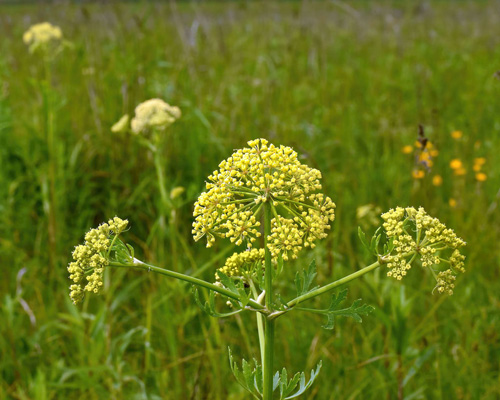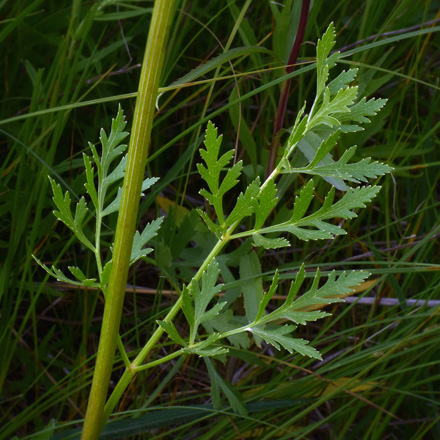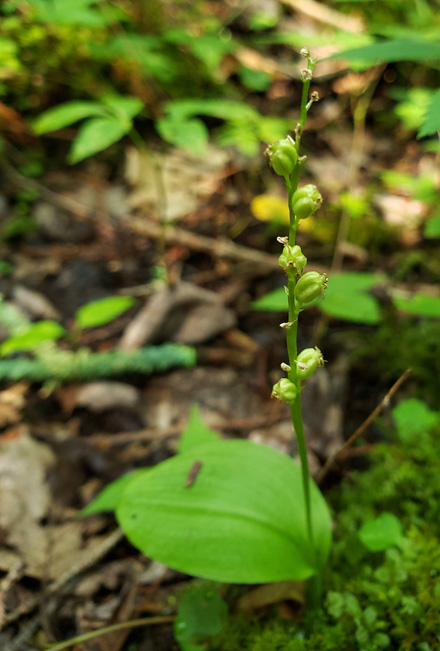Prairie Parsley (Polytaenia nuttallii) (left) and White Adder's-mouth (Malaxis monophyllos var. brachypoda). Photos courtesy of Dave Czoschke and Kevin Doyle.
Each year, the Rare Plant Monitoring Program picks plants deserving special attention for the following year. In 2024, we will have two species of the year. Monitors are not required to survey these plants, but we hope they might consider it. By highlighting these plants, we hope to get a fuller picture of their statuses in the state. If you have been unsure about choosing a survey in the past, these plants are a great place to start. Our 2024 species will provide opportunities throughout the state, so consider requesting a survey near you for the coming year.
Prairie parsley (Polytaenia nuttallii)

Species Overview
Prairie parsley (Polytaenia nuttallii) is a Wisconsin-threatened plant in the carrot family. In the state, 44 populations have been reported, but only five have been observed in the last 20 years. In addition, six populations have been surveyed recently without success.
Habitat and Range
Prairie parsley stretches from Texas to Wisconsin, where it is found across the southern half of the state in dry to wet-mesic high-quality prairies and open areas that were once savannas. Commonly associated plant species include big bluestem, giant goldenrod, stiff goldenrod, flowering spurge, downy phlox, common spiderwort, hoary puccoon and needle grass.
Biology
Prairie parsley is a biennial or short-lived perennial. After germinating, it remains as a basal rosette for two or more years. When conditions are right, it flowers, fruits and then dies. Plants are often pollinated by small bees, flies and wasps. Although one plant can produce many seeds, many of these will not grow to maturity. Prairie parsley seed requires a long winter dormancy, and plants are slow to develop even when germination occurs.
Identification Tips
The best time to identify prairie parsley is when it is in flower, in May and June, or in fruit, through August. Many members of the carrot family have white flowers, so prairie parsley’s yellow flowers are a good feature for identification. It can be distinguished from other yellow-flowering members of the carrot family by its leaves, which are two or three-times compound. It is most likely to be confused with golden alexanders or the non-native wild parsnip, but these have much less finely divided leaves than prairie parsley.
Conservation Concerns
At the southern end of its range, prairie parsley seems more secure, but in Wisconsin, it has been declining in recent years. This is likely due to multiple factors, including the loss of native prairie to agricultural and commercial development and lack of capacity to manage remaining prairie and savanna habitat. Prairie parsley is fire dependent and requires active management to remove thick layers of thatch from building up and preventing seed germination. Many of its historical populations in Wisconsin have likely already been lost, but we hope rare plant monitors might prove us wrong this year!

White Adder's-mouth (Malaxis monophyllos var. brachypoda)
Species Overview
White adder's-mouth (Malaxis monophyllos var. brachypoda) is one of 17 rare orchids native to Wisconsin. In the state, 52 populations of white adder's-mouth have been reported. However, only 16 of these have been observed in the past 20 years. Five populations have been surveyed recently without success.

Habitat and Range
White adder's-mouth is found in conifer or black ash swamps, often in heavily shaded areas. Common associates include northern white-cedar, balsam fir, black spruce, black ash, sphagnum, gray alder, queen lady's-slipper, goldthread and small bishop's-cap. Populations are scattered throughout the northern half of the state, with a high concentration in the northeast. There are also a couple of records from the southeast, though only one of these has been seen in the last 100 years.
Biology
Not much is known about the biology of white adder's-mouth. Fitting with its small flowers, it is pollinated by small flies or fungus gnats. Like many other orchids, its fruit is a capsule, and its sawdust-like seeds are spread by air currents. White adder's-mouth can also regenerate each year via underground pseudobulbs.
Identification Tips
The optimal identification period for white adder's-mouth is June through August. Blooming occurs in June, and flowers can be distinguished from those of other orchids by their small size and their lower lip, which is unlobed and broad at the base with an abruptly narrowed, triangular tip. Another key feature for identifying white adder's-mouth is a single leaf that sheaths the stem. Green adder's-mouth (Malaxis unifolia) has a similar single leaf attached to the stem but has much smaller and greener flowers that cluster at the top of the inflorescence.
Conservation Concerns
Most populations of white adder's-mouth are small and may be easily overlooked. However, small population sizes make this species more vulnerable to disturbances. The largest threat to this species is likely climate change, as populations will be impacted by drought, warming temperatures and extreme weather. White adder's-mouth is also affected by herbivory, logging and invasive species. It is currently tracked as an S3 species in Wisconsin.
